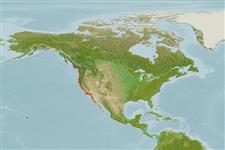>
Acipenseriformes (Sturgeons and paddlefishes) >
Acipenseridae (Sturgeons) > Acipenserinae
Etymology: Acipenser: Latin, acipenser = sturgeon, 1853 (Ref. 45335); transmontanus: The specific name is derived from the Latin acipenser (sturgeon), trans (beyond), and montanus (mountain) (Ref. 27436).
More on author: Richardson.
Environment: milieu / Klimaatzone / Diepte / distribution range
Ecologie
marien; zoet water; brak water demersaal; anadroom (Ref. 51243); diepte 1 - 122 m (Ref. 27547). Temperate; 0°C - 23°C (Ref. 1998); 58°N - 24°N, 163°W - 107°W (Ref. 54269)
Eastern Pacific: Alaska Bay to Monterey, California, USA. Landlocked in Columbia River drainage, Montana, and perhaps Lake Shasta in California, USA. Translocated to lower Colorado River, Arizona in USA. Reported from northern Baja California, Mexico (Ref. 2850, 27436).
Lengte bij maturiteit / Grootte / Gewicht / Leeftijd
Maturiteit: Lm 160.0 range ? - ? cm
Max length : 610 cm TL mannelijk / geslacht onbekend; (Ref. 1998); common length : 21.0 cm TL mannelijk / geslacht onbekend; (Ref. 12193); max. gepubliceerd gewicht: 816.0 kg (Ref. 27436); max. gerapporteerde leeftijd: 104 Jaren (Ref. 39377)
Dorsale stekels (totaal) : 0; Dorsale zachte stralen (totaal) : 44 - 48; Anale zachte stralen: 28 - 31. Distinguished by the 2 rows of 4 to 8 bony plates on a midventral line between the anus and anal fin, and about 45 rays in the dorsal fin (Ref. 27547). Gray or brownish above, paler below; fins gray (Ref. 27547). Barbels situated closer to snout tip than to mouth; no obvious scutes behind dorsal and anal fins (Ref. 86798).
Body shape (shape guide): elongated.
Spends most of its time in the sea, usually close to shore (Ref. 27547). Enters estuaries of large rivers and moves far inland to spawn (Ref. 5723). Individuals larger than 48.3 cm feed mainly on fishes; smaller ones feed mainly on chironomids, but also takes small crustaceans, other insects and mollusks (Ref. 1998). Feeding ceases just before spawning (Ref. 1998). Excellent food fish that is sold fresh, smoked or frozen (Ref. 9988). Eggs marketed as caviar (Ref. 1998). In the past, the airbladder was made into isinglass (Ref. 27547).
Adults return to the sea after spawning (Ref. 27547). Spawning frequency interval every 4 years for younger females and every 10-11 years in older females (Ref. 1998).
Page, L.M. and B.M. Burr, 1991. A field guide to freshwater fishes of North America north of Mexico. Houghton Mifflin Company, Boston. 432 p. (Ref. 5723)
Status op de Rode Lijst van het IUCN (Ref. 130435: Version 2025-1)
Gevaar voor de mens
Harmless
Gebruik door de mens
Visserij: commercieel; Aquacultuur: commercieel; sportvis: ja
Tools
Speciale rapporten
Download XML
Internetbronnen
Estimates based on models
Preferred temperature (Ref.
123201): 8.3 - 12.2, mean 9.7 °C (based on 80 cells).
Fylogenetische diversiteitsindex (Ref.
82804): PD
50 = 0.5000 [Uniqueness, from 0.5 = low to 2.0 = high].
Bayesian length-weight: a=0.00302 (0.00153 - 0.00597), b=3.19 (3.02 - 3.36), in cm total length, based on LWR estimates for this species & Genus-body shape (Ref.
93245).
Trofisch niveau (Ref.
69278): 3.3 ±0.1 se; based on diet studies.
Generation time: 27.5 ( na - na) years. Estimated as median ln(3)/K based on 1
growth studies.
Weerstandsvermogen (Ref.
120179): Zeer laag, minimale populatieverdubbelingstijd meer dan 14 jaar (tm=11-34; tmax=104).
Fishing Vulnerability (Ref.
59153): Very high vulnerability (87 of 100).
🛈
Climate Vulnerability (Ref.
125649): Moderate to high vulnerability (48 of 100).
🛈
Nutrients (Ref.
124155): Calcium = 8.84 [4.78, 17.65] mg/100g; Iron = 0.244 [0.136, 0.429] mg/100g; Protein = 17.4 [14.8, 20.2] %; Omega3 = 0.293 [0.147, 0.585] g/100g; Selenium = 31.4 [14.7, 69.3] μg/100g; VitaminA = 4.45 [1.29, 16.47] μg/100g; Zinc = 0.377 [0.252, 0.570] mg/100g (wet weight);
